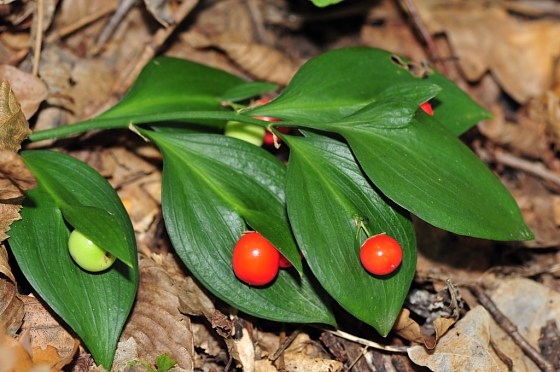Spineless Butcher’s-Broom
(Ruscus hypoglossum)
Spineless Butcher’s-Broom (Ruscus hypoglossum)
/
/

Andrew Karpov
Public domain
Image By:
Andrew Karpov
Recorded By:
Copyright:
Public domain
Copyright Notice:
Photo by: Andrew Karpov | License Type: Public domain | License URL: https://creativecommons.org/public-domain/ | Uploader: File Upload Bot (Magnus Manske) | Publisher: Wikimedia Commons | Title: Ruscus_hypoglossum_at_The_Grand_Canyon_Of_Crimea.jpg | Notes: Uploaded own work with UploadWizard |


































Estimated Native Range
Summary
Ruscus hypoglossum, commonly known as Spineless Butcher’s-Broom, is a small evergreen subshrub native to the understory of woodlands, forest edges, and cliffs in Southern Europe and Western Asia. It typically reaches about 46 cm (18 in) in height and is known for its unique leaf-like phylloclades, which are actually flattened stems, measuring about 8 cm (3 in) long and 4 cm (1+1⁄2 in) wide, tapering at both ends. True leaves are reduced to small green appendages around the flowers. In late winter to early spring, it produces small yellow flowers in the axil of a leaf-like bract on the upper side of the phylloclade. Being dioecious, male and female flowers are found on separate plants. On female plants, fruit is a red berry, rarely produced, that is 0.6 to 1.3 cm (0.25 to 0.5 in) wide.
Spineless Butcher’s-Broom is valued for its ability to thrive in shaded conditions and its low maintenance requirements, making it a suitable choice for ground cover in woodland gardens, shaded borders, and as an underplanting for larger shrubs or trees. It is also used in floral arrangements and as a traditional medicinal plant. It prefers part shade to full shade and adapts to a range of soil drainage conditions, from slow to fast, with medium to high water requirements. While it is generally pest and disease-free, it can occasionally suffer from scale insects. Its slow growth rate and non-aggressive roots make it a well-behaved garden plant, but it may require patience to establish and spread.CC BY-SA 4.0
Spineless Butcher’s-Broom is valued for its ability to thrive in shaded conditions and its low maintenance requirements, making it a suitable choice for ground cover in woodland gardens, shaded borders, and as an underplanting for larger shrubs or trees. It is also used in floral arrangements and as a traditional medicinal plant. It prefers part shade to full shade and adapts to a range of soil drainage conditions, from slow to fast, with medium to high water requirements. While it is generally pest and disease-free, it can occasionally suffer from scale insects. Its slow growth rate and non-aggressive roots make it a well-behaved garden plant, but it may require patience to establish and spread.CC BY-SA 4.0
Plant Description
- Plant Type: Subshrub
- Height: 1-1.3 feet
- Width: 2-3 feet
- Growth Rate: Slow
- Flower Color: N/A
- Flowering Season: Spring
- Leaf Retention: Evergreen
Growth Requirements
- Sun: Part Shade, Full Shade
- Water: Medium, High
- Drainage: Slow, Medium, Fast
Common Uses
Bank Stabilization, Groundcover, Low Maintenance
Natural Habitat
Native to the understory of woodlands, forest edges, and cliffs in Southern Europe and Western Asia
Other Names
Common Names: Mouse Thorn, Horse Tongue Lily, Fragon Hypoglosse, Tungmyrten
Scientific Names: , Ruscus hypoglossum, Ruscus hypoglossum var. laticladodia, Platyruscus hypoglossum, Ruscus alexandrinus, Ruscus alexandrinus oppr, Ruscus humilis, Ruscus hypophyllum var. hypoglossum, Ruscus troadensis,
GBIF Accepted Name: Ruscus hypoglossum L.